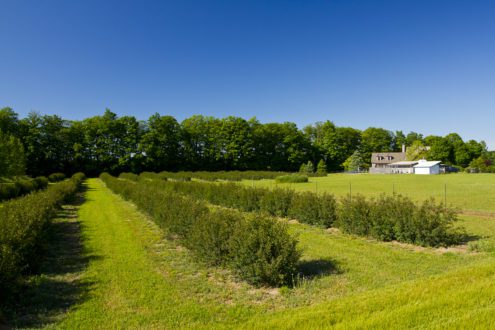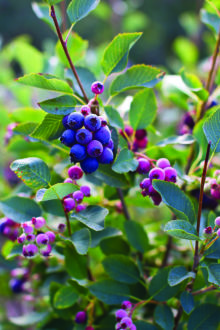

May 10, 2018Northern growers find sideline crops in hardy specialty fruit selections
Growers and researchers in the upper Midwest are finding a number of specialty fruits as a second or third crop – a sideline for growers who continue to farm other traditional selections for their livelihoods.
These alternative crops vary somewhat, but they do have a few elements in common: They’re hardy. They’re different. They can be sold as superfruit.
Here are some of the specialty crops growers are pursuing.


Aronia
Kathy Wiederholt is the fruit project manager of the University of North Dakota’s Carrington Research Extension Center, trying to develop an array of new fruit crops suited to the state’s climate. Farmers most frequently ask about aronia – also known as chokeberries.
While some aronia grow native, most cultivars are of eastern European origin. They are thought to originate from a cross between aronia and European mountain ash by Russian pomologist Ivan Michurin.
Weiderholt said most U.S. aronia are produced in Iowa and Nebraska. Nationwide, the number of cultivated acres has swollen from about 65 in 2010 to 1,819 acres in 2017. There is now a national Midwest Aronia Association that meets each year in Omaha.
What’s different: Aronia are high in tannins, vitamins, antioxidants, anthocyanins and proanthocyanins. Raw, they have an astringint flavor, part of the reason they’re also called chokeberries. If consumed raw, aronia will quickly dry out the mouth.
How hardy they are: Wiederholt said aronia are Zone Three hardy, fit for some of the coldest areas in the northern Midwest. “They grow in many different soil conditions,” she said. Irrigation is helpful but not often necessary. Some growers use plastic or mulch to discourage weeds. Not many insects bother aronia, so “it’s a crop that lends itself to organic growing.” The berries ripen the end of August to early-to-mid September. Growers with more than half an acre could try to use a mechanical harvester, a shaking device.
What the market is: Because of their nutritional value, aronia are often marketed as a superfruit. They are unpalatable if consumed raw but are often sold fresh-frozen. They are useful for processing and are often added to wine. The berries lose their astringency when combined with dairy products. Wiederholt said that is because the proteins bond with the tannins.
More information: www.ag.ndsu.edu/CarringtonREC


Saskatoons
Wiederholt said saskatoons, also called juneberries, are among the most promising crops in trials of her program in North Dakota.
Saskatoons are also grown in extensively in Michigan, where more than 20 commercial growers cultivate the berries. Rick Cross, 72, was one of the first in northwest Michigan to try to grow Saskatoons, importing three-year-old seedlings from Alberta a dozen years ago. He’s harvested about 10 crops since that time.
“When you look at them, they look like a blueberry … but they’re actually small apples,” he said. “They’re a pome fruit.”
What’s different: Saskatoons have a sweet, nutty flavor. They are high in fiber, protein, antioxidants and calcium and can be eaten raw in addition to being used in processing.
How hardy they are: Saskatoons handle the cold well and are native to much of North America, as far north as Alaska. Wiederholt said the most genetic diversity of the plants are in Alberta and Saskatchewan. Several cultivars have been established for crop growing, but she said they are difficult to propagate from seeds or cuttings.
Cross said seedlings are difficult to establish and “don’t compete with weeds very well at all.”
However, “once you get them going, they’re pretty hard to kill,” he said.
Despite the plants being hard to kill, Cross warns against neglecting the bushes, which are susceptible to insects and fungal pathogens.
“You have to farm them,” he said. “You can’t just plant them and walk away from them.
“We prune them significantly because they’ll get 15-20 feet high.”
Berries ripen in late June or early July. Cross picks his saskatoons by hand for fresh sales. Pickers average about 20 pounds an hour per person. He has his own berry-washing system set up at the farm, and then sells the fresh berries in Northwest Michigan.
What the market is: Cross grows just an acre and a half of the bushes. He said it would be difficult for him to scale up his saskatoon crop for a variety of reasons, but mostly because he only sells fresh. “There’s no one set up to process these,” he said.
Cross said the fresh berries only have a shelf life of five or six days and should probably be consumed 10 days after harvest. That time frame doesn’t leave much time to transport the berries, growers have found.
“I think people had to figure out the fresh market is a local market,” he said. But the berries have caught on locally and the markets he supplies often sell out, he said.
More information: www.saskatoonberryinstitute.com


Elderberries
Chris Patton is president of the Midwest Elderberry Cooperative, a group of growers with about 1,000 acres devoted to commercial elderflower and elderberry production in North America. Patton grows the berries with partners on two farms Scandia, Minnesota and Amery, Wisconsin.
Elderberry shrubs often grow wild in open or semi-open areas on the edges of habitat such as along streams and roadways and have clusters of shiny purple-black fruit.
What’s different: Elderberries shouldn’t be eaten raw, but are useful as ingredients in many food products. Patton said many growers become interested in elderberries because it’s something new but stay involved in it because it’s a perennial crop with long-term potential. The berries are prized for their nutritional value.
How hardy they are: Elderberries are very “flexible,” Patton said, and grow wild in a number of environments east of the Rocky Mountains. They handle cold well, but he has found that in northern Minnesota, the season is shorter.
A few cultivars produce the best fruit from a primocane that needs to be tended carefully, but other varieties can be mowed to the ground each year after harvest.
“It is vigorous as far as maintenance,” Patton said. “It’s like the energy is in the roots.”
The plants are quick to bounce back in the spring.
“If they’ve got any kind of soil, they’re going to get 6-10 feet of growth,” he said.
The harvest takes place from mid-August to mid-September. Ripe elderberries are attractive to spotted wing drosophila. The berries are in most cases harvested by hand; a mechanical harvester has not yet been developed. But Patton said the cooperative does have processing equipment to share, including a de-stemmer that can process as much as 500 pounds an hour.
What the market is: Because the berries shouldn’t be consumed raw, the market is for processed berries and processing products that can be added to other products for their color or nutritional value.
There is a strong demand for certified organic elderberry products. An 11-ounce bottle of organic elderberry juice can retail for $22 to $27, Patton said. Concentrate and juice in the United States compete with imports from Europe. Patton is hoping to develop a puree product for elderberries that can be easily added to yogurts and ice cream.
“It’s a pioneer kind of thing,” he said.
More information: www.midwest-elderberry.coop
– Stephen Kloosterman, FGN Assistant Editor
Top photo of a Saskatoons field by Rick Cross














